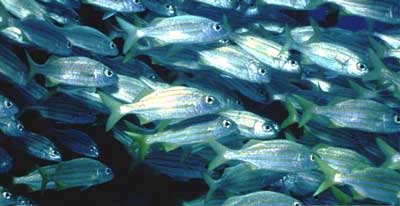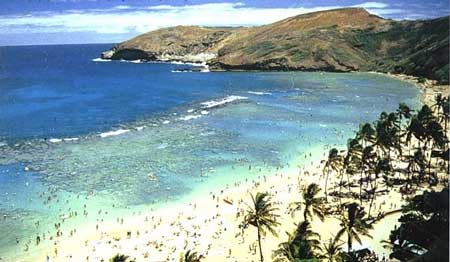1.3.1.6 Importance of reefs for the human society (cont...)
b) Food resource
 Reefs are very important in terms of food availability. Many lagoonal and open ocean fishes go to the reef to breed, feed on the reef plants or to catch prey. Estimations assume that up to 40% or more of world seafood nutrition depends on the reefs (## to be cross checked##). Besides fishes, many other animals, such as lobsters, reef shrimps and crabs, mollusks (bivalves, gastropods and cephalopods), in part even echinoderms and others are used as food for man.
Reefs are very important in terms of food availability. Many lagoonal and open ocean fishes go to the reef to breed, feed on the reef plants or to catch prey. Estimations assume that up to 40% or more of world seafood nutrition depends on the reefs (## to be cross checked##). Besides fishes, many other animals, such as lobsters, reef shrimps and crabs, mollusks (bivalves, gastropods and cephalopods), in part even echinoderms and others are used as food for man.
Interconnected ecosystems: Have you ever thought of the following? Reefs are connected to, and create, many other ecosystems, such as lagoons, mangroves and coral cays. Reefs in a more offshore position create lagoons which develop additional food resources. Mangroves will not form on high energy coasts, unless protected by a reef barrier. They are home of the land crabs, a very widely used food resource in the tropics. Storms pile up reef produced sands to sand cays which may become the home of coconut palms, another most important tropical food and multipurpose resource...
Tourism is a global player in world economy. Coastal tourism is the main income of the entire Caribbean, the Maldives, the Seychelles and many other tropical islands. It is a major income for Egypt, Australia and many southeastern states. Figures of moneys spent by tourist in the Caribbean alone are in the order of several 10ths of billions of US $ per year.
Although reef sites do have enormous crowds of visitors (Great Barrier Reef at least 2,5 millions per year, the small Pennekamp National Park of Florida has the same figure which is more than 5000 visitors per day; there are about 10 millions of recreational divers many of which visit reefs), most tourists spending their holidays in tropical countries do not even think of the existence of reefs. However, they would, to a large extend, not come if reefs wouldn't be there. Without reefs, most lagoons and white sand beaches would be gone (see paragraph a of this section); it is the reefs which create low energy, shallow lagoons, produce sand which accumulates on low-energy, paradise palm beaches, and even create many of the islands where tourist resorts are housed.
